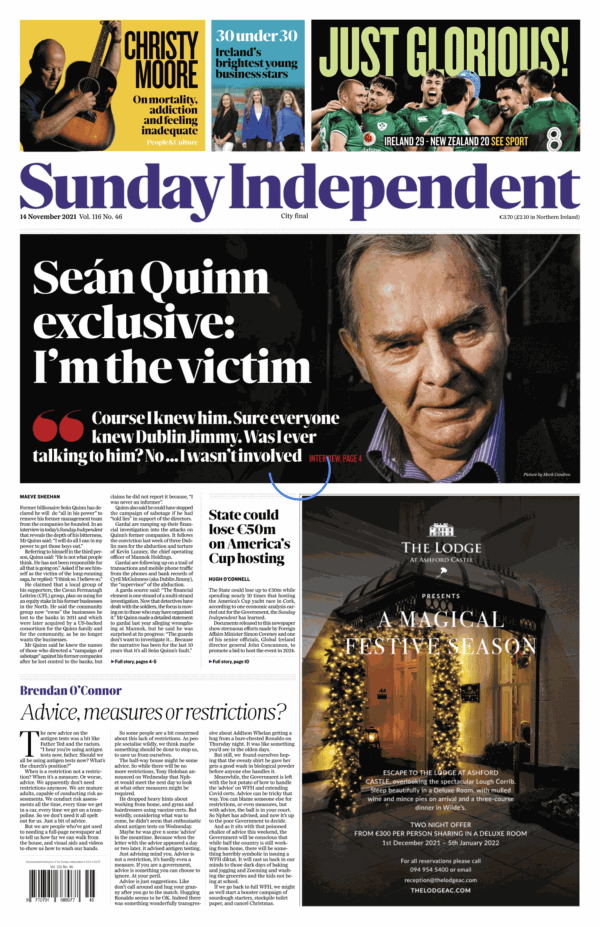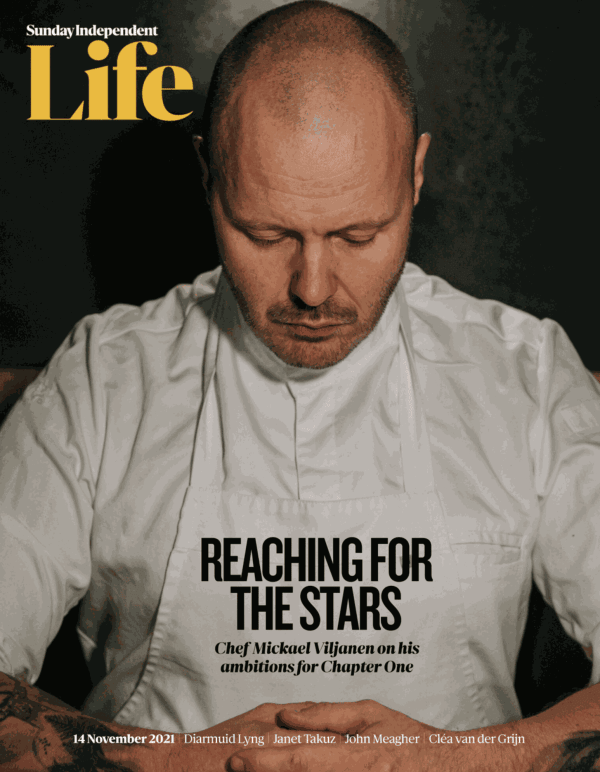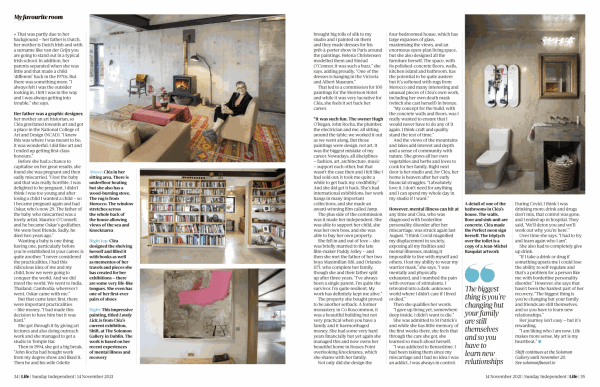There's a lot of discussion about mental health these days — much talk in sometimes vague terms about panic attacks and anxiety — but mental illness has been a taboo subject until very recently. Sufferers knew that the consequences of opening up about a diagnosis and symptoms could affect their positions at work and how they were treated by friends. In the past, mental illness meant stigma.
We tend to think that if a person is mentally ill they can't function like the rest of society. It's becoming clear, however, thanks to brave souls like rugby player Keith Earls — who recently revealed he has bipolar disorder — that this is patently not the case. You can be a high achiever and successful in many areas of life and still have mental illness.
Acclaimed artist Cléa Van Der Grijn is so determined to open up the discourse further that she has made her recent breakdown and diagnosis of borderline personality disorder the central point of her current exhibition, Shift, at the Solomon Gallery. She even invited consultant psychiatrist Dr Marie Naughton of St Patrick's University Hospital — who treated her when Cléa spent three months there last year — to write the foreword to the programme about her exhibition.
Dr Naughton is at pains to emphasise that we all have many layers. "I have come to know Cléa in a different context and in more difficult times. Now to be part of this celebration of her work and her talent is allowing access to a different dimension to this wonderful person. It is a clear demonstration that illness is a part of life but not the only part. People do get well, people do recover.”
The paintings — which are vibrant, colourful, intriguing and really impressive — are all inspired by Lewis Carroll's novel Alice in Wonderland which Cléa was drawn to during her illness. "I was particularly drawn to the not-so-subtle nuances of distorted reality in the story,” she says.
On the face of it, the Dublin-born artist has the perfect life; she is a successful painter, sculptor and film-maker; she has won awards for her work; she has travelled the world, and has three much-loved sons.
She also has a loving partner and a wonderful house in Sligo, which she designed herself. She's glamorous, charming, mischievous yet thoughtful and reflective as well. However, she has suffered tragedy — a miscarriage in her early 20s which affected her profoundly, as did the death of her much-loved only brother, Ruriko, in 2008 when he was in his 30s, and there were the deaths of others close to her, but underlying everything, she says she always felt different. » » That was partly due to her background — her father is Dutch, her mother is Dutch Irish and with a surname like van der Grijn you are going to stand out in a typical Irish school. In addition, her parents separated when she was little and that made a child 'different' back in the 1970s. But there was something more. "I always felt I was the outsider looking in. I felt I was in the way and I was always getting into trouble,” she says.
Her father was a graphic designer, her mother an art historian, so Cléa gravitated towards art and got a place in the National College of Art and Design (NCAD). "I knew this was where I was meant to be; it was wonderful. I did fine art and I ended up getting first-class honours.”
Before she had a chance to capitalise on her great results, she found she was pregnant and then sadly miscarried. "I lost the baby and that was really horrible. I was delighted to be pregnant, I didn't think I was too young and after losing a child I wanted a child — so I became pregnant again and had Oskar, who's now 29. The father of the baby who miscarried was a lovely artist, Maurice O'Connell, and he became Oskar's godfather. We were best friends. Sadly, he died two years ago.”
Wanting a baby is one thing; having one, particularly before you're established in your career, is quite another. "I never considered the practicalities. I had this ridiculous idea of me and my child, how we were going to conquer the world. And we did travel the world. We went to India, Thailand, Cambodia; wherever I went, Oskar came with me.”
But that came later, first, there were important practicalities — like money. "I had made this decision to have him but it was hard.”
She got through it by giving art lectures and also doing outreach work and she managed to get a studio in Temple Bar.
Then in 1994, she got a big break. "John Rocha had bought work from my degree show and liked it. Then he and his wife Odette brought big rolls of silk to my studio and I painted on them and they made dresses for his prêt-à-porter show in Paris around the paintings. Helena Christensen modelled them and Sinéad O'Connor, it was such a buzz,” she says, adding proudly, "One of the dresses is hanging in the Victoria and Albert Museum.”
That led to a commission for 100 paintings for the Morrison Hotel and while it was very lucrative for Cléa, she feels it set back her career.
"It was such fun. The owner Hugh O'Regan, John Rocha, the plumber, the electrician and me, all sitting around the table; we worked it out as we went along. But those paintings were design, not art. It was the biggest mistake of my career. Nowadays, all disciplines — fashion, art, architecture, music — support each other, but that wasn't the case then and I felt like I had sold out; it took me quite a while to get back my credibility.” And she did get it back. She's had international exhibitions, her work hangs in many important collections, and she made an award-winning film called Jump.
The plus side of the commission was it made her independent. She was able to support her child, she was her own boss, and she was able to buy her own property.
She fell in and out of love — she was briefly married to the late film-maker Paddy Jolley — and then she met the father of her two boys Maximilian (18), and Orlando (17), who complete her family, though she and their father split up after three years. "I've always been a single parent. I'm quite the survivor. I'm quite resilient. My work has definitely kept me alive.”
The property she bought proved to be another setback. A former monastery in Co Roscommon, it was a beautiful building but not very practical when you have a family and it haemorrhaged money. She had some very hard years financially but yet again she managed this and now owns her beautiful home in Rosses Point overlooking Knocknarea, which she shares with her family.
Not only did she design the four-bedroomed house, which has large expanses of glass, maximising the views, and an enormous open-plan living space, but she also designed all the furniture herself. The space, with its polished-concrete floors, walls, kitchen island and bathroom, has the potential to be quite austere but it's softened with rugs from Morocco and many interesting and unusual pieces of Cléa's own work, including her own death mask (which she cast herself) in bronze.
"My concept for the build, with the concrete walls and floors, was I really wanted to ensure that I would never have to do any of it again. I think craft and quality stand the test of time.”
And the views of the mountains and lakes add interest and depth and a sense of community with nature. She grows all her own vegetables and herbs and loves to cook for her family. Right next door is her studio and, for Cléa, her home is heaven after her early financial struggles. "I absolutely love it. I don't need for anything and I can spend my whole day in my studio if I want.”
However, mental illness can hit at any time and Cléa, who was diagnosed with borderline personality disorder after her miscarriage, was struck again last August. "I think Covid magnified my displacement in society, exposing all my frailties and mental illnesses, making it impossible to live with myself and others. I lost my ability to wear my warrior mask,” she says. "I was mentally and physically exhausted, and I numbed the pain with overuse of stimulants. I retreated into a dark, unknown world where I didn't care if I lived or died.”
Then she qualifies her words.
"I gave up living yet, somewhere deep inside, I didn't want to die.”
She was admitted to St Patrick's and while she has little memory of the first weeks there, she feels that through the care she got, she learned so much about herself.
"I was addicted to Benzedrine. I had been taking them since my miscarriage and I had no idea I was an addict, I was always in control. During Covid, I think I was drinking more; drink and drugs don't mix, that control was gone, and I ended up in hospital. They said, 'We'll detox you and we'll work out why you're here'.”
Over time she says, "I had to try and learn again who I am”.
She also had to completely give up drink.
"If I take a drink or drug if something upsets me I could lose the ability to self-regulate and that's a problem for a person like me with borderline personality disorder.” However, she says that hasn't been the hardest part of her recovery. "The biggest thing is you're changing but your family and friends are still themselves, and so you have to learn new relationships.”
Her journey isn't easy — but it's rewarding.
"I am liking who I am now. Life makes more sense. My art is my heartbeat.”
Shift continues at the Solomon Gallery until November 20.
See www.solomonfineart.ie





